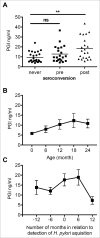When is Helicobacter pylori acquired in populations in developing countries? A birth-cohort study in Bangladeshi children
- PMID: 29494270
- PMCID: PMC6219588
- DOI: 10.1080/19490976.2017.1421887
When is Helicobacter pylori acquired in populations in developing countries? A birth-cohort study in Bangladeshi children
Abstract
Helicobacter pylori colonization is prevalent throughout the world, and is predominantly acquired during childhood. In developing countries, >70% of adult populations are colonized with H. pylori and >50% of children become colonized before the age of 10 years. However, the exact timing of acquisition is unknown. We assessed detection of H. pylori acquisition among a birth cohort of 105 children in Mirzapur, Bangladesh. Blood samples collected at time 0 (cord blood), and at 6, 12, 18, and 24 months of life were examined for the presence of IgG and IgA antibodies to whole cell H. pylori antigen and for IgG antibodies to the CagA antigen using specific ELISAs and immunoblotting. Breast milk samples were analyzed for H. pylori-specific IgA antibodies. Cord blood was used to establish maternal colonization status. H. pylori seroprevalence in the mothers was 92.8%. At the end of the two-year follow-up period, 50 (47.6%) of the 105 children were positive for H. pylori in more than one assay. Among the colonized children, CagA prevalence was 78.0%. A total of 58 children seroconverted: 50 children showed persistent colonization and 8 (7.6%) children showed transient seroconversion, but immunoblot analysis suggested that the transient seroconversion observed by ELISA may represent falsely positive results. Acquisition of H. pylori was not influenced by the mother H. pylori status in serum or breastmilk. In this population with high H. pylori prevalence, we confirmed that H. pylori in developing countries is detectable mainly after the first year of life.
Keywords: CagA; acquisition; breast feeding; developing countries; epidemiology; seroconversion; serological diagnostic testing; seroprevalence; transmission.
Figures


References
-
- Torres J, Perez-Perez G, Goodman KJ, Atherton JC, Gold BD, Harris PR, la Garza AM, Guarner J, Munoz O. A comprehensive review of the natural history of Helicobacter pylori infection in children. Arch Med Res. 2000;31:431–69. doi: - PubMed
-
- Rowland M, Daly L, Vaughan M, Higgins A, Bourke B, Drumm B. Age-specific incidence of Helicobacter pylori. Gastroenterology. 2006;130:65–72; quiz 211. doi: - PubMed
-
- Miendje Deyi VY, Vanderpas J, Bontems P, Van den Borre C, De Koster E, Cadranel S, Burette A. Marching cohort of Helicobacter pylori infection over two decades (1988-2007): combined effects of secular trend and population migration. Epidemiol Infect. 2011;139:572–80. doi:10.1017/S095026881000110X - DOI - PubMed
Publication types
MeSH terms
Substances
Grants and funding
LinkOut - more resources
Full Text Sources
Other Literature Sources
Medical
Miscellaneous
